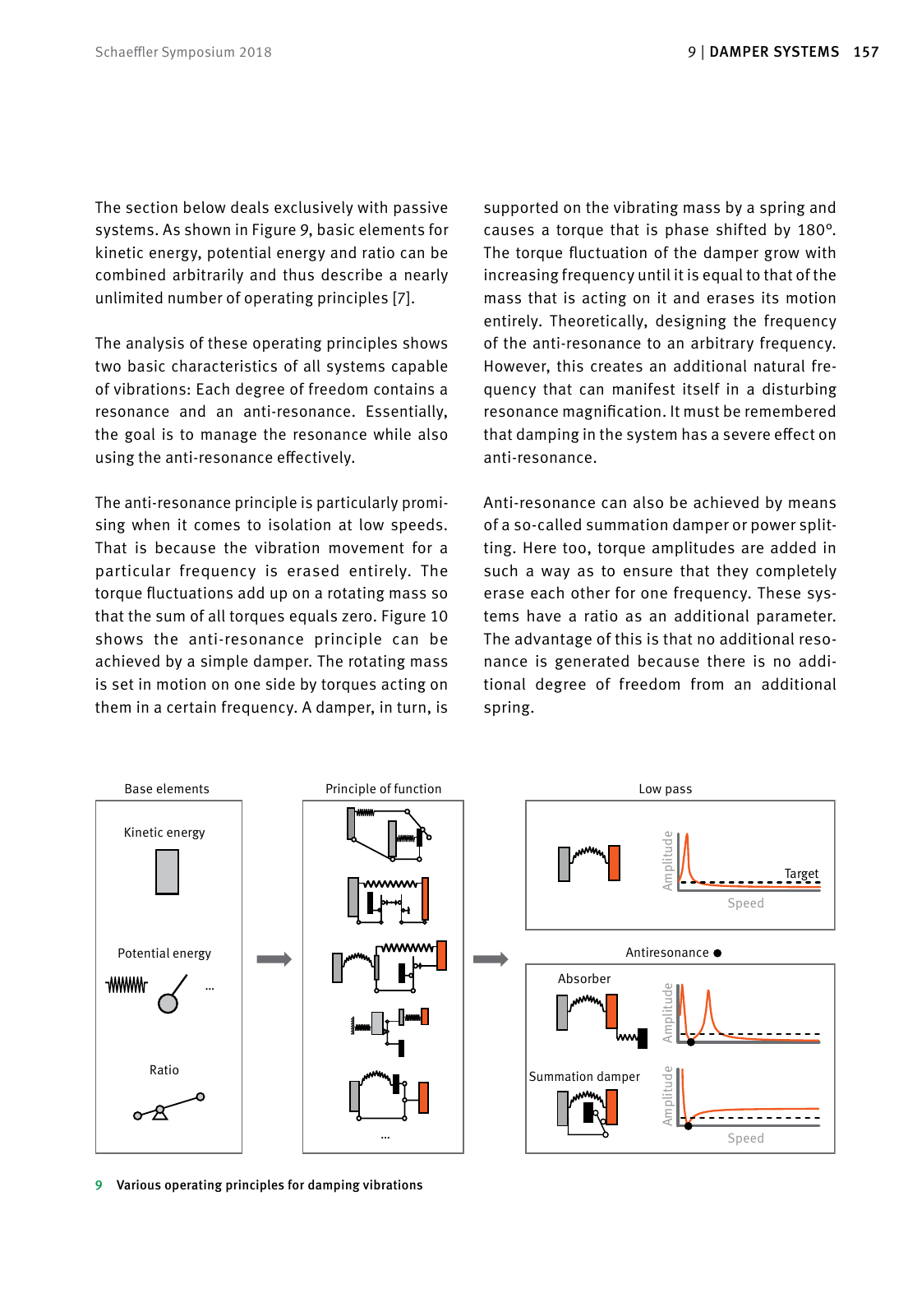156 DAMPER SYSTEMS 9 1579 DAMPER SYSTEMSSchaeffler Symposium 2018 New approaches to vibration damping Analyses at the operating principle level In Schaeffler s search for new damping concepts one approach consists of using simple models to analyze different operating principles at the theo retical level These models focus on operational parameters and are compared on a physical basis while maintaining the same inertia and spring en ergies Limiting factors such as design space costs and feasibility are not included until the second step If an operating principle proves to be promising the function of the new concept is ana lyzed with regard to expanded operating situa tions such as an engine start In a simulated vehi cle model this is carried out with all relevant non linearities Generally there are three types of vibration damper systems Active systems Energy is supplied to and ex tracted from the system externally This can be carried out for instance by an electric motor in the powertrain to produce a counter excitation Another possibility are semi active systems in which a parameter such as a spring rate is simulated specifically Passive systems Energy is stored temporarily alternating between kinetic and potential ener gy such as in a classic spring mass damper such as the DMF or the CPA which temporarily stores potential energy in the centrifugal force field Slipping systems Energy is removed from the system This can be achieved hydraulically such as in a torque converter or through fric tion such as in a clutch 6 Good results can also be achieved with an effi cient combination of all of these systems The section below deals exclusively with passive systems As shown in Figure 9 basic elements for kinetic energy potential energy and ratio can be combined arbitrarily and thus describe a nearly unlimited number of operating principles 7 The analysis of these operating principles shows two basic characteristics of all systems capable of vibrations Each degree of freedom contains a resonance and an anti resonance Essentially the goal is to manage the resonance while also using the anti resonance effectively The anti resonance principle is particularly promi sing when it comes to isolation at low speeds That is because the vibration movement for a particular frequency is erased entirely The torque fluctuations add up on a rotating mass so that the sum of all torques equals zero Figure 10 shows the anti resonance principle can be achieved by a simple damper The rotating mass is set in motion on one side by torques acting on them in a certain frequency A damper in turn is supported on the vibrating mass by a spring and causes a torque that is phase shifted by 180 The torque fluctuation of the damper grow with increasing frequency until it is equal to that of the mass that is acting on it and erases its motion entirely Theoretically designing the frequency of the anti resonance to an arbitrary frequency However this creates an additional natural fre quency that can manifest itself in a disturbing resonance magnification It must be remembered that damping in the system has a severe effect on anti resonance Anti resonance can also be achieved by means of a so called summation damper or power split ting Here too torque amplitudes are added in such a way as to ensure that they completely erase each other for one frequency These sys tems have a ratio as an additional parameter The advantage of this is that no additional reso nance is generated because there is no addi tional degree of freedom from an additional spring Reversed SRD CPA Crankshaft Prim Sec DC E mot Trans Veh Base DMF 1 000 2 000 3 000 An gl e Am pl itu te Speed in rpm Speed in rpm Sp ee d Am pl itu de IsolationCrankshaft without absorber 2 000 4 000 6 000 Basis DMF Reversed SRD 8 Reversed small radial damper RSRD with CPA and flywheel on front end of the crankshaft Antiresonance Base elements Principle of function Absorber Summation damper Kinetic energy Potential energy Ratio Target Speed Low pass Speed Am pl itu de Am pl itu de Am pl it ud e 9 Various operating principles for damping vibrations

Hinweis: Dies ist eine maschinenlesbare No-Flash Ansicht.
Klicken Sie hier um zur Online-Version zu gelangen.
Klicken Sie hier um zur Online-Version zu gelangen.